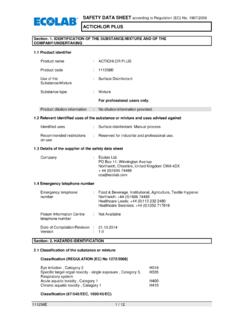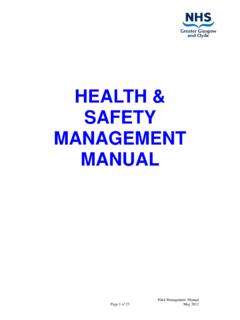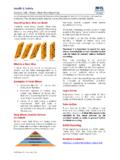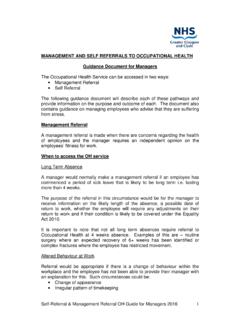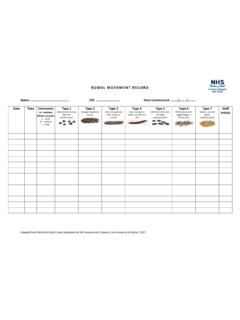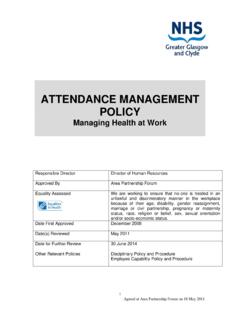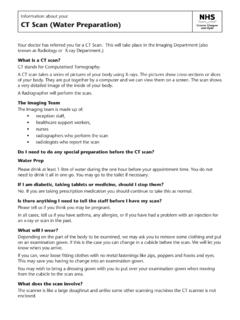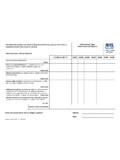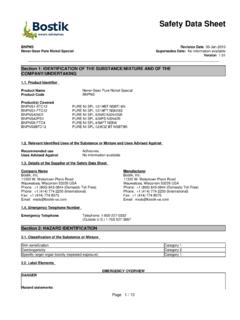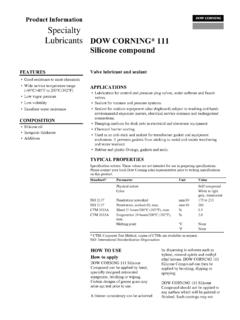Transcription of Safety Data Sheet - NHSGGC : Homepage NHSGGC
1 Safety data Sheet 10% Neutral Buffered Formalin #120 Page 1 of 9 Issue Date: 22 August 2013 SECTION 1: IDENTIFICATION OF THE SUBSTANCE/MIXTURE AND THE COMPANY/ UNDERTAKING Product Identifier Trade Name Product # SDS # 10% Neutral Buffered Formalin 3800598 3800600 3800650 3800604EG 3800811C120 SDS Date August 22, 2013 Relevant Identified Uses of the Substance or Mixture and Uses Advised Against Product Use: Tissue Fixation Uses Advised Against: All other uses. Details of the Supplier of the Substance or Mixture Manufacturer/Preparer: Leica Biosystems Richmond, Inc. 5205 Route 12 Richmond, IL 60071 800-225-8867 Leica Biosystems Canada, Inc.
2 83 Terracon Place Winnipeg, Manitoba R2J 4B3 800-665-7425 Emergency Telephone Number Emergency Spill Information 1-800- 424-9300 (CHEMTREC) +1 703-527-3887 International calls (call collect) Other Product Information: 1-800-225-8867 SECTION 2: HAZARDS IDENTIFICATION Classification of the Substance or Mixture CLP/GHS Classification (1272/2008): Physical: Health: Environmental Not Hazardous Eye Damage Category 1 Skin Irritation Category 2 Skin Sensitization Category 1 Carcinogenicity Category 1A Specific Target Organ Toxicity Single Exposure Category 1 Not Hazardous EU Classification (67/548/EEC: Xn, Xi, R36/37/38, R43, R40, R20/21/22 Label Elements DANGER!)
3 Contains methanol, formaldehyde #120 Page 2 of 9 Issue Date: 22 August 2013 Hazard Phrases H315 Causes skin irritation. H317 May cause an allergic skin reaction. H318 Causes serious eye damage. H350 May cause cancer. H370 Causes damage to nervous system and eyes. Precautionary Phrases P201 Obtain special instructions before use. P202 Do not handle until all Safety precautions have been read and understood. P260 Do not breathe mist/vapours/spray. P264 Wash thoroughly after handling. P270 Do not eat, drink or smoke when using this product. P272 Contaminated work clothing should not be allowed out of the workplace. P280 Wear protective gloves/protective clothing/eye protection/face protection.
4 P305 + P351 + P338 IF IN EYES: Rinse cautiously with water for several minutes. Remove contact lenses, if present and easy to do. Continue rinsing. P310 Immediately call a POISON CENTER or doctor/physician. P302 + P352 IF ON SKIN: Wash with plenty of soap and water. P333 + P313 If skin irritation or rash occurs: Get medical advice/attention. P362 Take off contaminated clothing and wash before reuse. P308 + P313 IF exposed or concerned: Get medical advice/ attention. P405 Store locked up. P501 Dispose of contents/container in accordance with local and national regulations. Other Hazards: None SECTION 3: COMPOSITION/INFORMATION ON INGREDIENTS Substances Chemical Name CAS Number / EINECS Number / REACH Reg.
5 Number % (w/w) EU Classification (67/548/EEC) CLP/GHS Classification (1272/2008) Formaldehyde 50-00-0 200-001-8 <6 T, Xn (Carc. Cat. 3), C, Xi R40, R23/24/25, R34, R43 Carcinogenicity Category 1A (H350), Acute Toxicity Category 3 (H301, H311, H331) Skin Corrosion Category 1B (H314) Eye Corrosion Category 1 (H318) Skin Sensitization Category 1 (H317) Aquatic Acute Toxicity Category 3 (H402) Methanol 67-56-1 200-659-6 <2 F, T R11, R23/24/25, R39/23/24/25 Flammable Liquid Category 2 (H225) Acute Toxicity Category 3 (H301, H311, H331) #120 Page 3 of 9 Issue Date: 22 August 2013 Specific Target Organ Toxicity Single Exposure Category 1 (H370) SECTION 4: FIRST AID MEASURES Description of First Aid Measures First Aid Eye contact.
6 Immediately flush eye with water for at least 15 minutes while lifting the upper and lower lids. Get immediate medical attention. Skin contact: Remove contaminated clothing. Wash thoroughly with soap and water. Get medical attention if irritation persists. Launder before reuse. Inhalation: Remove victim to fresh air. If breathing is difficult have qualified individual administer oxygen and get immediate medical attention. If breathing stops, give artificial respiration. Get immediate medical attention. Ingestion: Do not induce vomiting unless directed to do so by medical personnel. If the victim is conscious and alert, have them rinse their mouth with water.
7 Never give anything by mouth to an unconscious or drowsy person. Get immediate medical attention. See Section 11 for more detailed information on health effects. Most Important symptoms and effects, both acute and delayed: May cause severe eye irritation or burns. May cause skin irritation. May cause an allergic skin reaction. Inhalation of vapors may cause nose, throat or upper respiratory tract irritation and nervous system effects including dizziness, drowsiness, nausea, vomiting, visual disturbances and unconsciousness. Potential Cancer Hazard. Risk of cancer depends on the level and duration of exposure. Indication of any immediate medical attention and special treatment needed: Immediate medical treatment is required for eye contact and ingestion.
8 SECTION 5: FIREFIGHTING MEASURES Extinguishing Media: Use dry chemical, foam, carbon dioxide (CO2), or water spray. Special Hazards Arising from the Substance or Mixture Unusual Fire and Explosion Hazards: None known. Combustion Products: Oxides of carbon, smoke. Advice for Fire-Fighters: Self-contained breathing apparatus and protective clothing should be worn in fighting large fires involving chemicals. Determine the need to evacuate or isolate the area according to your local emergency plan. Use water spray to keep fire exposed containers cool. SECTION 6: ACCIDENTAL RELEASE MEASURES #120 Page 4 of 9 Issue Date: 22 August 2013 Personal Precautions, Protective Equipment and Emergency Procedures: Wear appropriate protective equipment.
9 Ventilate the area. Environmental Precautions: Prevent entry in storm sewers and waterways. Report spill as required by local and federal regulations. Methods and Material for Containment and Cleaning Up: Small Spill and Leak: Dilute with water and mop, or absorb with inert dry material and place in an appropriate waste disposal container. Use D-Formalizer pads or Formaldehyde Control Granules to reduce formaldehyde exposure. Large Spill and Leak: Stop leak if it is safe to do so. Absorb with DRY earth or non-combustible material. Ensure airborne concentrations of formaldehyde do not exceed published exposure limits. Additional protective equipment may be required, Reference to Other Sections: Refer to Section 8 for personal protective equipment and Section 13 for disposal information.
10 SECTION 7: HANDLING and STORAGE Precautions for Safe Handling: Prevent eye and skin contact. Do not breathe vapors or mists. Use only with adequate ventilation. Wash thoroughly after handling. Remove contaminated clothing and launder before re-use. Keep containers closed when not in use. Some countries may have special requirements for handling formaldehyde. In the United States refer to OSHA for requirements for handling and use of formaldehyde solutions. Conditions for Safe Storage, Including any Incompatibilities: Protect containers from physical damage. Store in a cool area. Keep containers closed when not in use. Store away from oxidizers.
